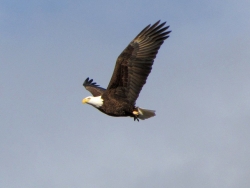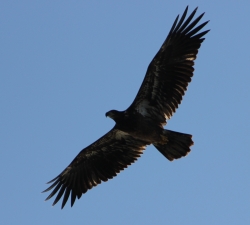
Copyright © 2011 Bryant Olsen
Copyright © 2011 Bryant Olsen
Copyright © 2011 Terry Greene
Copyright © 2011 Terry Greene
Copyright © 2011 Terry Greene, Photographer
When winter arrives in Utah, a number of our bird species hit the road – some flying thousands of miles to Mexico and Central America in search of a warm winter home.
But there is one notable bird that actually migrates to Utah in the winter – the bald eagle. In general, birds migrate because of seasonal food shortages. Think of the hummingbirds that rely on flower nectar and insects, which Utah cannot provide in winter, but which are abundant other times of the year. The same is true for bald eagles, whose main food source is fish. Winter comes on strong in Alaska and Canada, freezing lakes, ponds, and all but the strongest flowing rivers. So the birds travel to seek out the relatively mild winters found farther south.
One of the largest birds of prey you’ll see in our Utah skies, a mature bald eagle can have a wingspan of 6 to 8 feet and stand almost three feet tall. Only the golden eagle rivals it in size. Pairs are thought to mate for life, and they are also responsible for the largest nests of any bird in North America. One record-setting abode measured 9 feet wide, 20 feet deep, and weighed more than 2 tons.
And to think, we almost lost this incredible species. Since DDT and hunting heavily affected bald eagle numbers in the early half of the 20th century, the birds have made a truly remarkable comeback. From a low point around 4,000 individuals in the lower 48 states, they are now thought to number in the tens of thousands, and have been removed from the Threatened and Endangered Species lists.
Perhaps as their comeback continues, Utah will once again see these majestic animals make their massive nests here, fishing in our many rivers and lakes year round. For now, though, aside from a few rare exceptions, bald eagle enthusiasts will have to make the most of their short winter stay. To observe bald eagles, consider a visit to the Great Salt Lake Nature Center at Farmington Bay. Every year, the Bay plays host to hundreds of eagles, from November to March, and while this milder-than-usual winter has brought in fewer numbers of eagles, you may still be able to catch a glimpse. They will likely be heading north later this month, however, so don’t delay. And be sure to keep your ears tuned into the bald eagle’s haunting song:
[Bald Eagle call from https://wildstore.wildsanctuary.com/collections/special-collections Kevin Colver https://wildstore.wildsanctuary.com/collections/special-collections]
Thank you to the Rocky Mountain Power Foundation for supporting the research and development of this Wild About Utah topic. For the Stokes Nature Center and Wild About Utah, this is Andrea Liberatore.
For the Stokes Nature Center and Wild About Utah, this is Andrea Liberatore.
Credits:
Audio: Courtesy & Copyright Kevin Colver
Photos: Courtesy & Copyright Bryant Olsen and
Courtesy & Copyright Terry Greene
Text: Andrea Liberatore, Stokes Nature Center, logannature.org
Additional Reading:
Parrish, J. and Walters, B., Editors. (2009) Bald Eagle (Haliaeetus leucocephalus). Utah Division of Wildlife Resources: Wildlife Notebook Series No. 3. https://wildlife.utah.gov/publications/pdf/2010_bald_eagle.pdf
National Geographic Society (2012) Animals: Bald Eagle (Haliaeetus leucocephalus)
https://animals.nationalgeographic.com/animals/birds/bald-eagle/




